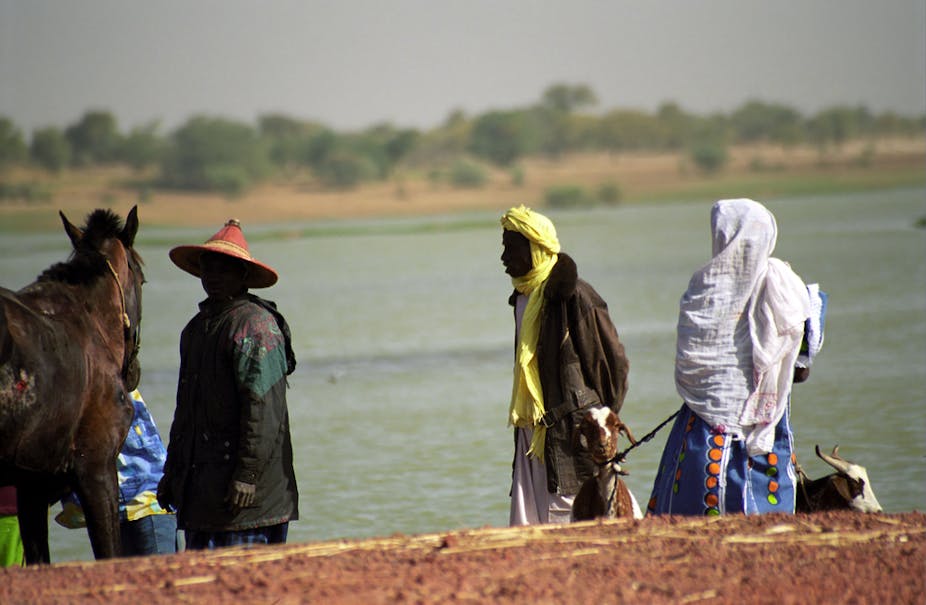For millions of livestock owners across Africa, a disease in the herd can mean hardship or even ruin. Access to effective veterinary treatment is therefore essential for many people’s livelihoods.
Many factors can make getting good treatment difficult, such as a shortage of vets and the high cost of care. To make things worse, counterfeit or substandard drugs have penetrated many marketplaces, and are often hard to tell apart from the real thing. While regulators scramble to catch up with this problem, livestock owners must work out their own ways of coping.
The quality of medicine for humans has long been a major public health problem, particularly in developing countries. Products are sometimes sold without little or no active ingredient or without correct labelling – sometimes imitating the packaging of well-known companies. Such deceptions can be as simple as a shopkeeper diluting bottled medicines, or involve sophisticated international criminal networks.
The true scale of the problem is difficult to pinpoint, though some research indicates that fake and substandard drugs are a significant proportion of all drugs sold globally, and are a multi-billion dollar industry.

A $400 million problem
In the past decade, there have been impressive efforts to tackle the human drug quality problem. However, the issue of veterinary drug safety and security remains largely below the radar.
The International Federation of Animal Health estimates that the trade in sub-standard and non-registered drugs in Africa is worth US$400m a year – the same size as the official market. The manufacturers, sellers, and customers I’ve spoken to over believe that the problem has been around for decades, but has got much worse in the last five to ten years.
Some research has tried to estimate the quality of drugs that treat trypanosomiasis and other animal diseases. But it remains frustratingly difficult to get a clear view of the problem. This is in part because testing drug quality is difficult – even where facilities exist, it can cost several hundred US dollars to test a single sample.
Rural livestock owners – an afterthought?
As considerable progress has been made in cleaning up the human drug market, why has Africa’s veterinary drug problem been left behind? One reason is that since the 1980s, public veterinary services in many African countries have been greatly reduced. This decline has had far-reaching consequences, not least in the loss of network of veterinarians well-placed to identify and report dubious products.
More broadly, the withdrawal of public veterinary services means that many livestock owners are forced to improvise when looking after their animals. Diseases must be tackled with a patchwork of private veterinarians, “paravets” and livestock workers (with variable levels of training), and local knowledge.
A lot can go wrong in this Wild West free-for-all: diseases with similar symptoms can be easily misdiagnosed, mistakes can be made in the tricky task of judging doses correctly, and even good quality drugs can be rendered useless by being stored incorrectly or used after their expiry date. Because of this, fake or substandard drugs are just one possible cause amongst many for treatment failure – meaning that it is difficult to definitely prove that a particular batch of drugs is substandard.
Doing it themselves
My own research with Fulani pastoralists in Nigeria’s middle belt demonstrates that cattle owners are well aware of the presence of dubious products. Customers are not always able to reliably identify dubious products – a fake pill does not come apart at the seams like a fake pair of Levi’s. Instead, they systematically experiment with small quantities of several drugs to identify effective ones, and use medicines in careful combinations to avoid the risk of failure in any one product.
Nigerian urban elites often discuss Fulani cattle owners with a certain condescension. But the Fulani are far from passive victims: building on their expertise and efforts to secure good quality treatment would be a good place for regulators and veterinary authorities to start.
Solutions – soft and hard
To tackle the human drug quality problem in Nigeria, the National Agency for Food and Drug Administration and Control (NAFDAC) has followed a uncompromising strategy of prosecutions and well-publicised seizures and burnings of drugs. While these efforts have been rightly celebrated, improving veterinary drug safety may require a different approach. Many in Nigeria prescribe and sell veterinary drugs without the necessary licences – but it would achieve little to harshly prosecute such vendors when government support and regulation has been ineffective for so long.
A better approach might emphasise training for both vendors and customers of drugs, alongside more rigorous licensing and investigations. NAFDAC launched a new veterinary and animal products directorate in 2013 to address these issues, which along with the good reputation of the agency is cause for optimism.
There is urgent need for more research across the continent, cheaper ways of testing drugs, and most of all, better use of livestock owners’ own knowledge and skills.

